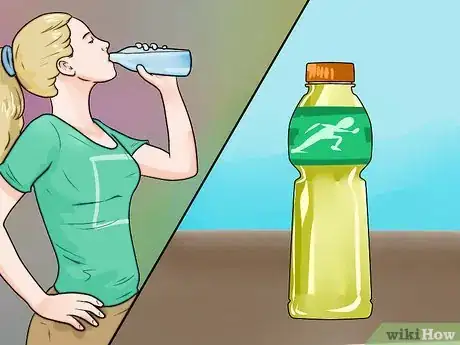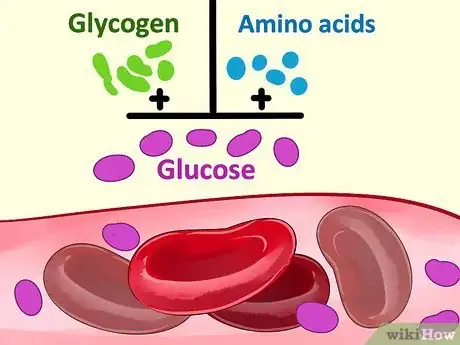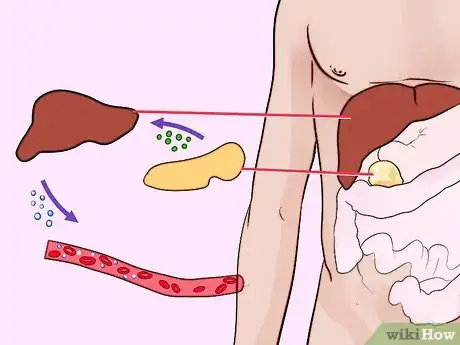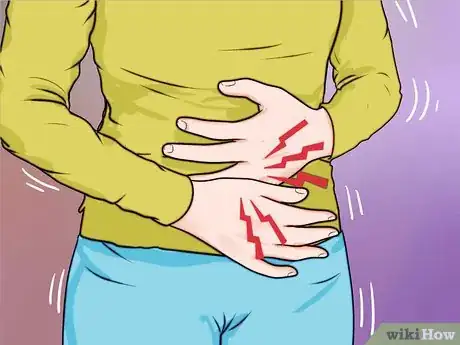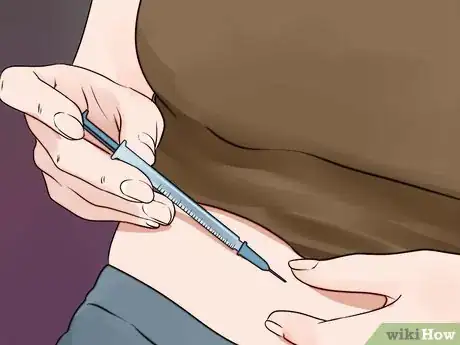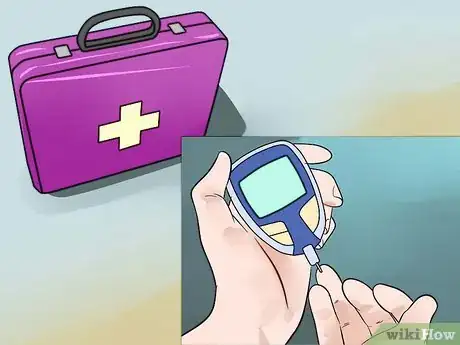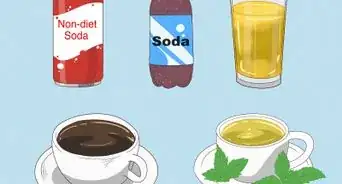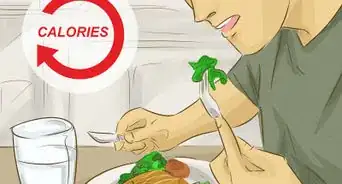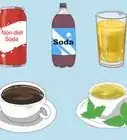This article was co-authored by Kristi Acuna. Kristi Acuna is a Holistic Nutritionist and the Owner of Holistic Nutrition Center in Orange County, California. With over 15 years of experience, Kristi specializes in a comprehensive and holistic approach to nutrition through nutrition response testing, heart rate variability, thermography, and brainspan. She has experience helping with weight gain, fatigue, insomnia, food allergies, diabetes, irritable bowel syndrome, digestion problems, sinus infections, and PMS and menopause symptoms. Kristi holds a BS in Holistic Nutrition from Clayton College of Natural Health. Holistic Nutrition Center focuses on the root cause of health challenges and helps people heal and restore balance to their bodies.
There are 15 references cited in this article, which can be found at the bottom of the page.
This article has been viewed 191,986 times.
Glycogen is the fuel reserve that keeps our body running. Glucose, obtained from carbohydrates in our diet, provides the energy we need throughout the day. Sometimes, the glucose in our body runs low, or even is depleted. When that happens, the body pulls the needed energy from glycogen stores in muscle and liver tissue, converting the glycogen into glucose. Exercise, illness, and some dietary habits, can cause the glycogen stores to be depleted more quickly. Steps to restore the depleted glycogen can vary depending on the underlying reasons for the depletion.
Steps
Restoring Glycogen after Exercise
-
1Understand the glucose-glycogen cycle. The carbohydrates in your diet are broken down to create glucose. Dietary carbohydrates provide the basic components needed to keep glucose in your blood so you have enough energy for your daily routines.[1]
- When your body senses that you have extra glucose, it converts the glucose to glycogen by a process called glycogenesis. The glycogen is stored in muscle and liver tissue.[2]
- As your blood glucose levels begin to run low, your body converts the glycogen back to glucose by a process called glycolysis.[3]
- Exercise can deplete the glucose in your blood more quickly, causing your body to pull on the reserved glycogen.[4]
-
2Know what happens during anaerobic and aerobic exercise. Anaerobic exercise involves short bursts of activity, such as weightlifting and muscle development and training. Aerobic exercise involves longer episodes of sustained activity that cause your heart and lungs to work harder.[5]
- During anaerobic exercise, your body uses the glycogen stored in the muscle tissue. This causes you to reach a point of muscle exhaustion when you do several sets of repetitive muscle training exercises.[6]
- Aerobic exercise utilizes the glycogen stored in your liver. Prolonged aerobic exercise, like marathon running, causes you to reach a point where those stores are depleted.[7]
- When that happens, you may not have enough glucose in your blood to properly fuel your brain. This can result in symptoms consistent with hypoglycemia, including fatigue, poor coordination, feeling dizzy, and problems with concentration.[8]
Advertisement -
3Consume simple carbohydrates immediately following an intense workout. Your body has a two hour window immediately following exercise during which it more effectively restores your glycogen.[9]
- Opt for a healthy snack like a protein shake with almond butter, broccoli sprouts, and 1/4 of an avocado. This contains protein, fat, and carbohydrates, which will help restore your depleted glycogen.[10]
- Simple carbohydrates include foods and beverages that are easily broken down by your body,[11] such as fruits, milk, chocolate milk, and vegetables. Foods prepared with refined sugars are also sources of simple carbohydrates, such as cakes and candies, however these sources lack nutritional value.[12]
- Research suggests that consuming 50 grams of carbohydrates every two hours increases the rate of restoring the depleted glycogen stores. This method increased the rate of replacement from an average of 2% per hour, to 5% per hour.[13]
-
4Expect at least 20 hours to restore the glycogen. Consuming 50 grams of carbohydrates every two hours will take from 20 to 28 hours to completely restore the amount of glycogen depleted.[14]
- This factor is considered by athletes and their trainers in the days immediately prior to an endurance event.[15]
-
5Prepare for an endurance event. Athletes work to develop higher levels of endurance in order to compete in events like marathons, triathlons, cross country skiing, and distance swimming events. They also learn to manipulate their own glycogen stores to compete more effectively.[16]
- Hydration for an endurance event begins about 48 hours before the big day. Keep a container filled with water on you constantly for the days leading up to your endurance event. Drink as much as you can during those two days.[17]
- Begin your high-carbohydrate eating two days before the event. Try to select high-carbohydrate foods that also have nutritional value. Examples include whole grains, brown rice, sweet potatoes, and whole grain pasta.[18]
- Include fruits, vegetables, and lean protein in your meals. Avoid alcohol and processed foods.[19]
-
6Consider carbohydrate loading. Carbo loading methods are used by athletes that participate in endurance events, or events that last longer than 90 minutes. Carbo loading involves timing and selection of foods high in carbohydrate content to help expand the glycogen stores beyond their average levels.[20]
- Completely depleting the glycogen stores prior to the event, then loading with carbohydrates, works to expand the glycogen storage capacity even further. This allows the athlete to push harder and further, and hopefully improve his performance during the event.[21]
- The most traditional method for carbohydrate loading starts about a week before the event. Change your regular diet to include about 55% of your total calories as carbohydrates, with protein and fat added in as the remainder. This depletes your carbohydrate stores.[22]
- Three days prior to the event, adjust your carbohydrate intake to reach 70% of your daily calories. Decrease your intake of fat, and reduce your level of training.[23]
- Carbo loading methods are not reported to be helpful for events that are less than 90 minutes.[24]
-
7Eat a meal rich in carbohydrates just before an endurance event. By doing so, the body will work to quickly change the carbohydrates into usable energy, providing even greater energy benefit.[25]
-
8Drink sports drinks. Drinking sports beverages during an athletic event can help by providing a continued source of carbohydrates to your system, plus the added caffeine, available in some products, helps to improve endurance. Sports drinks contain sodium and potassium to maintain your electrolyte balance.
- Recommendations for sports beverages consumed during long periods of exercise include products that have from 4% to 8% carbohydrate content, 20 to 30 mEq/L of sodium, and 2 to 5 mEq/L of potassium.
Understanding Glycogen Stores in Diabetes
-
1Consider the function of insulin and glucagon. Insulin and glucagon are hormones made by the pancreas.
- Insulin works to move glucose into the cells of the body for energy, remove excess glucose from the blood stream, and convert the excess glucose to glycogen.
- Glycogen is stored in muscle and liver tissue for later use, when more glucose is needed in the blood.
-
2Know what glucagon does. When the blood level of glucose drops, the body signals the pancreas to release glucagon.
- Glucagon changes the stored glycogen back into usable glucose.
- The glucose pulled from the glycogen stores is needed to provide the energy we need to function each day.
-
3Be familiar with changes caused by diabetes. In people that have diabetes, the pancreas does not function normally, therefore hormones like insulin and glucagon are not adequately produced or released in the body.
- Inadequate levels of insulin and glucagon means that the glucose in the blood is not properly pulled into the cells of tissues to be used as energy, the excess glucose in the blood is not adequately removed to be stored as glycogen, and what is stored as glycogen cannot be pulled back into the blood when it is needed for energy.
- The ability to utilize glucose in the blood, store it as glycogen, and then access it again, is impaired. Therefore, diabetics are at greater risk of developing hypoglycemia.
-
4Recognize the symptoms of hypoglycemia. While anyone can experience hypoglycemia, patients that suffer with diabetes are more susceptible to episodes of abnormally low levels of glucose in the blood, otherwise known as hypoglycemia.
- Common symptoms of hypoglycemia include the following:
- Feeling hungry
- Feeling shaky or nervous
- Feeling dizzy or light-headed
- Sweating
- Sleepiness
- Confusion and difficulty speaking
- Feelings of anxiety
- Feeling weak
-
5Know the risks. A severe and untreated hypoglycemic episode can lead to seizures, coma, and even death.[26]
-
6Use insulin or other medications for diabetes. Since the pancreas does not function normally, oral and injectable medications can help.
- Medications work to provide the balance needed to help the body properly perform both glycogenesis and glycolysis.
- While the available medications are saving lives every day, they are not perfect. Patients with diabetes are at risk of developing hypoglycemic events, even by simple changes in their daily routine.
- In some cases, the hypoglycemic events can be severe and even life-threatening.
-
7Stick to your eating and exercise regimens. Even the smallest change can cause unwanted results. Talk to your doctor before making any changes in your food choices and exercise routine.
- If you are diabetic, altering the foods you eat, the amount of foods and beverages you consume, and changes in your level of activity, can result in complications. For example, exercising, which is an important part of diabetic health, can create problems.
- During exercise, more energy, or glucose, is needed, so your body will try to pull from your glycogen stores. Impaired glucagon functioning causes less than adequate amounts of glycogen to be pulled from the stores in muscle and liver tissue.
- This can mean a delayed, and possibly severe, episode of hypoglycemia. Even several hours after exercise, the body will continue to work to restore the glycogen used during exercise. The body will pull the glucose from the blood supply, triggering a hypoglycemic event.[27]
-
8Treat an episode of hypoglycemia. Hypoglycemia comes on fairly quickly in someone that is diabetic. Any signs of dizziness, fatigue, confusion, difficulty comprehending a statement, and having trouble responding, are warning signs.
- The initial steps to treating a mild hypoglycemic episode involve consuming glucose or simple carbohydrates.
- Help the diabetic person to consume 15 to 20 grams of glucose, as gel or tablets, or as simple carbohydrates. Some food items that can be used include raisins, orange juice, sodas with sugar, honey, and jellybeans.
- As the blood sugar returns to normal, and enough glucose is getting to the brain, the person will become more alert. Continue to provide foods and beverages until the person recovers. If there is ever any question about what to do, call 911.
-
9Prepare a kit. People with diabetes may want to have a small kit prepared that contains glucose gel or tablets, possibly injectable glucagon, plus simple directions for someone else to follow.
- The diabetic person may quickly become disoriented, confused, and unable to treat themselves.
- Have glucagon available. If you are diabetic, talk to your doctor about having injectable glucagon available to help manage any severe episodes of hypoglycemia.[28]
- The glucagon injection works like natural glucagon, and helps to restore the balance of glucose in your blood.[29]
-
10Consider educating friends and family. A diabetic person having a severe hypoglycemic episode will not be able to administer the injection.[30]
- Friends and family members, educated about hypoglycemia, will know how and when to proceed with an injection of glucagon.[31]
- Invite your family or friends to an appointment with your doctor. The risk of not treating a severe episode of hypoglycemia goes beyond any risk associated with the injection.[32]
- Your doctor can help to reassure your caregivers of the importance of treating a hypoglycemic episode.[33]
- Your doctor is your best resource and guide. He or she can help you decide if your condition warrants having a glucagon injection available to treat potentially serious hypoglycemic events. Glucagon injections require a prescription.[34]
Restoring Glycogen Due to Low Carbohydrate Diets
-
1Be cautious with low carbohydrate diets. Talk to your doctor to be sure this type of weight loss plan is safe for you.[35]
- Understand the risks. To safely pursue a highly restricted carbohydrate diet, which usually involves consuming less than 20 grams per day of carbohydrates, you must factor in your level of activity.[36]
- The initial period of a low carbohydrate diet significantly restricts the amount of carbohydrates a person is to consume. This helps your body to tap into stored glycogen as an aid in losing weight.[37]
-
2Limit the time you restrict your carbohydrate intake. Ask your doctor about safe time limits specific to your body type, level of activity, age, and existing medical conditions.[38]
- Limiting the highly restricted carbohydrate intake for 10 to 14 days allows your body to access the energy it needs while exercising, using blood glucose and stored glycogen.
- Resuming a higher carbohydrate intake at that time helps your body to restore the glycogen used.[39]
-
3Consider your exercise intensity. Your body pulls the energy it needs from the glucose in your blood, then pulls from glycogen reserves stored in your muscle and liver. Frequent and intense exercise depletes those stores.[40]
-
4Know what to expect. The most common result is feeling tired or weak, and having episodes of hypoglycemia.[43]
- You have depleted most of your glycogen stores and you are not putting very much back into your bloodstream. This results in less than enough energy to function normally and problems pursuing intense exercise.[44]
-
5Resume a higher carbohydrate content in your diet. After the initial 10 to 14 days of the low carbohydrate diet, move to a phase that allows for more carbs to be consumed, which allows your body to restore the glycogen.[45]
-
6Exercise moderately. If you are trying to lose weight, incorporating routine exercise is a great step to take.[46]
- Participate in moderate aerobic activity that lasts for more than 20 minutes. This helps you to lose weight, use enough energy to tap into your reserves, but avoid depleting your glycogen stores.[47]
Expert Q&A
Did you know you can get expert answers for this article?
Unlock expert answers by supporting wikiHow
-
QuestionHow to can you delay glucose depletion when exercising?
 Chris M. Matsko, MDDr. Chris M. Matsko is a retired physician based in Pittsburgh, Pennsylvania. With over 25 years of medical research experience, Dr. Matsko was awarded the Pittsburgh Cornell University Leadership Award for Excellence. He holds a BS in Nutritional Science from Cornell University and an MD from the Temple University School of Medicine in 2007. Dr. Matsko earned a Research Writing Certification from the American Medical Writers Association (AMWA) in 2016 and a Medical Writing & Editing Certification from the University of Chicago in 2017.
Chris M. Matsko, MDDr. Chris M. Matsko is a retired physician based in Pittsburgh, Pennsylvania. With over 25 years of medical research experience, Dr. Matsko was awarded the Pittsburgh Cornell University Leadership Award for Excellence. He holds a BS in Nutritional Science from Cornell University and an MD from the Temple University School of Medicine in 2007. Dr. Matsko earned a Research Writing Certification from the American Medical Writers Association (AMWA) in 2016 and a Medical Writing & Editing Certification from the University of Chicago in 2017.
Family Medicine Physician
-
QuestionHow can I help restore glycogen?
 Kristi AcunaKristi Acuna is a Holistic Nutritionist and the Owner of Holistic Nutrition Center in Orange County, California. With over 15 years of experience, Kristi specializes in a comprehensive and holistic approach to nutrition through nutrition response testing, heart rate variability, thermography, and brainspan. She has experience helping with weight gain, fatigue, insomnia, food allergies, diabetes, irritable bowel syndrome, digestion problems, sinus infections, and PMS and menopause symptoms. Kristi holds a BS in Holistic Nutrition from Clayton College of Natural Health. Holistic Nutrition Center focuses on the root cause of health challenges and helps people heal and restore balance to their bodies.
Kristi AcunaKristi Acuna is a Holistic Nutritionist and the Owner of Holistic Nutrition Center in Orange County, California. With over 15 years of experience, Kristi specializes in a comprehensive and holistic approach to nutrition through nutrition response testing, heart rate variability, thermography, and brainspan. She has experience helping with weight gain, fatigue, insomnia, food allergies, diabetes, irritable bowel syndrome, digestion problems, sinus infections, and PMS and menopause symptoms. Kristi holds a BS in Holistic Nutrition from Clayton College of Natural Health. Holistic Nutrition Center focuses on the root cause of health challenges and helps people heal and restore balance to their bodies.
Holistic Nutritionist
References
- ↑ http://www.medscape.com/viewarticle/438144_print
- ↑ http://www.medscape.com/viewarticle/438144_print
- ↑ http://www.medscape.com/viewarticle/438144_print
- ↑ http://thesportjournal.org/article/glycogen-replenishment-after-exhaustive-exercise/
- ↑ http://www.mayoclinic.org/healthy-lifestyle/fitness/expert-answers/weightlifting/faq-20057921
- ↑ http://www.mayoclinic.org/healthy-lifestyle/fitness/expert-answers/weightlifting/faq-20057921
- ↑ http://www.mayoclinic.org/healthy-lifestyle/fitness/expert-answers/weightlifting/faq-20057921
- ↑ http://diabetes.diabetesjournals.org/content/53/12/3041.long
- ↑ http://thesportjournal.org/article/glycogen-replenishment-after-exhaustive-exercise/
- ↑ Kristi Acuna. Holistic Nutritionist. Expert Interview. 17 September 2020.
- ↑ http://www.nlm.nih.gov/medlineplus/ency/imagepages/19534.htm
- ↑ http://www.nlm.nih.gov/medlineplus/ency/imagepages/19534.htm
- ↑ http://thesportjournal.org/article/glycogen-replenishment-after-exhaustive-exercise/
- ↑ http://thesportjournal.org/article/glycogen-replenishment-after-exhaustive-exercise/
- ↑ http://thesportjournal.org/article/glycogen-replenishment-after-exhaustive-exercise/
- ↑ http://thesportjournal.org/article/glycogen-replenishment-after-exhaustive-exercise/
- ↑ http://www.athleta.net/2010/08/23/preparing-for-an-endurance-race-10-tips/
- ↑ http://www.athleta.net/2010/08/23/preparing-for-an-endurance-race-10-tips/
- ↑ http://www.athleta.net/2010/08/23/preparing-for-an-endurance-race-10-tips/
- ↑ http://runnersconnect.net/running-nutrition-articles/carbohydrate-loading-marathon/
- ↑ http://runnersconnect.net/running-nutrition-articles/carbohydrate-loading-marathon/
- ↑ http://www.mayoclinic.org/healthy-lifestyle/nutrition-and-healthy-eating/in-depth/carbohydrate-loading/art-20048518
- ↑ http://www.mayoclinic.org/healthy-lifestyle/nutrition-and-healthy-eating/in-depth/carbohydrate-loading/art-20048518
- ↑ http://www.mayoclinic.org/healthy-lifestyle/nutrition-and-healthy-eating/in-depth/carbohydrate-loading/art-20048518
- ↑ http://www.ncbi.nlm.nih.gov/pmc/articles/PMC4042570/
- ↑ https://www.drugs.com/mtm/glucagon-emergency-kit-for-low-blood-sugar-injection.html
- ↑ http://www.diabetesselfmanagement.com/diabetes-resources/definitions/glycogen/
- ↑ http://www.diabetesselfmanagement.com/diabetes-resources/definitions/glycogen/
- ↑ http://www.diabetesselfmanagement.com/diabetes-resources/definitions/glycogen/
- ↑ http://www.diabetesselfmanagement.com/diabetes-resources/definitions/glycogen/
- ↑ http://www.diabetesselfmanagement.com/diabetes-resources/definitions/glycogen/
- ↑ https://www.drugs.com/mtm/glucagon-emergency-kit-for-low-blood-sugar-injection.html
- ↑ https://www.drugs.com/mtm/glucagon-emergency-kit-for-low-blood-sugar-injection.html
- ↑ https://www.drugs.com/mtm/glucagon-emergency-kit-for-low-blood-sugar-injection.html
- ↑ http://www.mayoclinic.org/healthy-lifestyle/weight-loss/in-depth/low-carb-diet/art-20045831
- ↑ http://www.mayoclinic.org/healthy-lifestyle/weight-loss/in-depth/low-carb-diet/art-20045831
- ↑ http://www.mayoclinic.org/healthy-lifestyle/weight-loss/in-depth/low-carb-diet/art-20045831
- ↑ http://www.mayoclinic.org/healthy-lifestyle/weight-loss/in-depth/low-carb-diet/art-20045831
- ↑ http://www.bengreenfieldfitness.com/2011/08/the-hidden-dangers-of-a-low-carbohydrate-diet/
- ↑ http://www.mayoclinic.org/healthy-lifestyle/weight-loss/in-depth/low-carb-diet/art-20045831
- ↑ http://www.mayoclinic.org/healthy-lifestyle/weight-loss/in-depth/low-carb-diet/art-20045831
- ↑ http://www.bengreenfieldfitness.com/2011/08/the-hidden-dangers-of-a-low-carbohydrate-diet/
- ↑ http://www.mayoclinic.org/healthy-lifestyle/weight-loss/in-depth/low-carb-diet/art-20045831
- ↑ http://www.mayoclinic.org/healthy-lifestyle/weight-loss/in-depth/low-carb-diet/art-20045831
- ↑ http://www.bengreenfieldfitness.com/2011/08/the-hidden-dangers-of-a-low-carbohydrate-diet/
- ↑ http://www.bengreenfieldfitness.com/2011/08/the-hidden-dangers-of-a-low-carbohydrate-diet/
- ↑ http://www.bengreenfieldfitness.com/2011/08/the-hidden-dangers-of-a-low-carbohydrate-diet/
About This Article
To restore glycogen after you work out, eat foods that contain simple carbohydrates, like fruits and vegetables. Try to eat them as soon as possible after working out, since your body restores glycogen the fastest during the 2-hour window right after you exercise. After that, aim to eat around 50 grams of carbs every 2 hours to continue replenishing your glycogen levels. If you eat carbs at that rate, it should take about 20 hours for all of the glycogen you lost to be restored. For advice from our Medical co-author, like how to restore glycogen while you're on a low-carb diet, keep reading!








